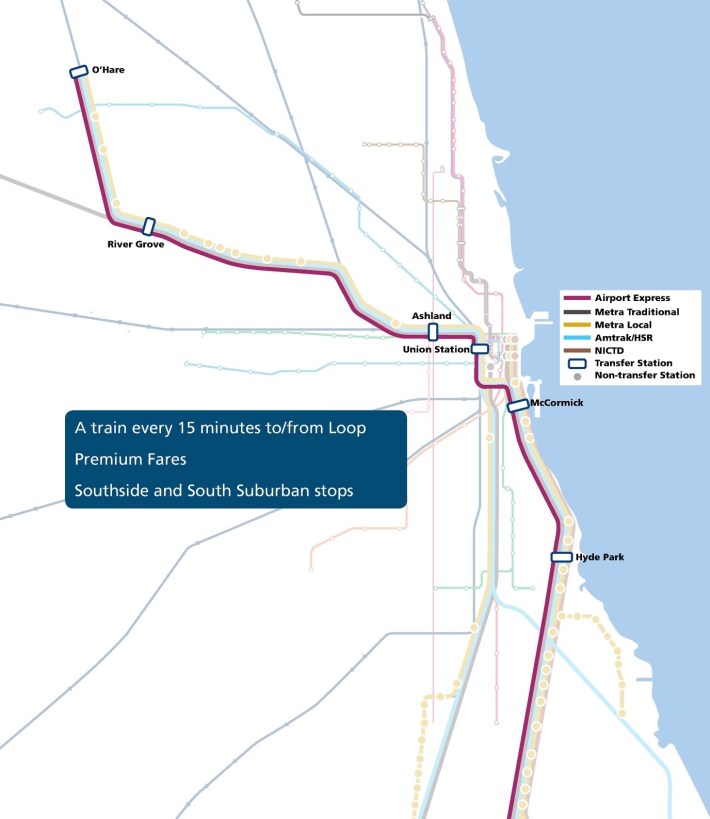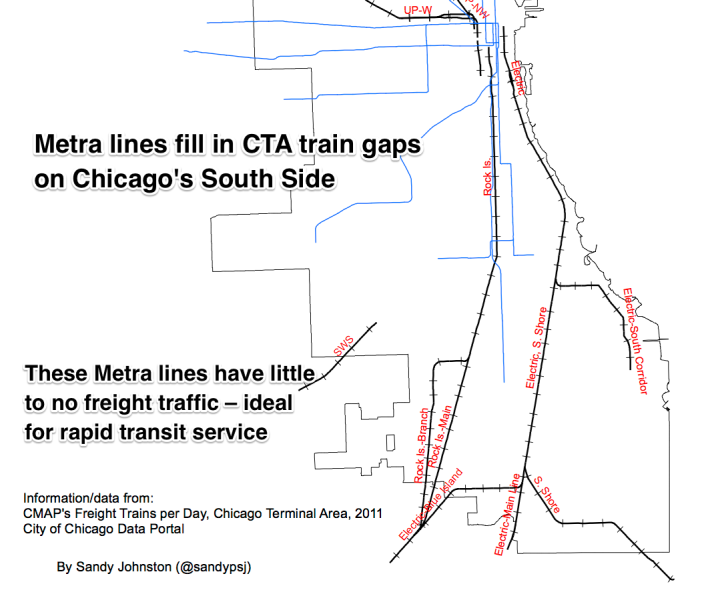
Mayor Rahm Emanuel and aviation commissioner Ginger Evans stated earlier this year that creating an express train to O'Hare Airport is a priority for this administration. However, the Blue Line is already a fairly speedy way to get to the airport, which could easily be upgraded via a few short-term improvements. Therefore, the city might be wiser to invest in neighborhood transit projects, rather than creating a premium service for well-heeled travelers.
Evans floated the rather fanciful idea of double-decking the Blue Line to create right-of-way for the express trains. However, if the O'Hare Express is going to happen, the Midwest High Speed Rail Association believes it should use the existing Metra infrastructure that’s located in the same airport-bound transportation corridor as the Blue Line and the Kennedy Expressway.
I recently sat down with executive director Rick Harnish to discuss MHSRA's proposal for "CrossRail," a package of Metra rail improvements that they say would increase the commuter rail system's reliability and create rider-friendly service patterns. The plan calls for linking the Metra Electric tracks with Union Station, by way of a new flyover and river crossing at 16th Street. Harnish said CrossRail would make faster trips to O'Hare possible by upgrading ancient infrastructure that Metra is already trying to replace, as well as adding new elements.
Whether Blue Line or Metra tracks are used for the O'Hare express, the project would cost about the same, Harnish said. He estimates that CrossRail would cost $2.2 billion, and says he's heard that a CTA solution would cost over $2 billion." A business plan for the airport express created for the CTA in 2006 [PDF] estimated that a Blue Line-parallel service with separate tracks would cost $1.5 billion.
Building tracks above the Blue Line, as Evans suggested this summer, would probably cost even more – assuming it would actually be possible to do so. "[That] comment from Evans about double-decking was either just completely off the cuff, or she was basically saying, if you want to pay for it, there's an engineering solution for it."
Investing in upgrades for an O'Hare express on Metra tracks could address the commuter rail service's existing needs. They want to upgrade track switches – the A2 switch dates back to 1932 – within Chicago that delay trains, and eliminate dangerous at-grade road crossings near the airport.
And, since CrossRail would connect the Union Station lines with the Metra Electric, which serves the South Side and south suburbs, there would be a wide base of political support for the investment. In other words, unlike a Blue Line-based O'Hare express service, CrossRail wouldn’t just be a project for affluent people traveling between the airport and the Loop. CrossRail is also proposing that the O'Hare-bound train could stop at Ashland near Union Park.
Ideally, CrossRail becomes part of a new high-speed train line that the state has been planning, starting at O'Hare and continuing through Champaign and Springfield, terminating in St. Louis.
Building a new train station at O'Hare's Terminal 5 with high-speed service to Union Station – which serves multiple Metra and bus routes, as well as Amtrak – should attract the support of lawmakers in Springfield. After all, the service would be convenient for downstaters and University of Illinois students who ride Amtrak into Chicago in order to fly from O'Hare.
CrossRail would also make it easier for Metra to provide shorter headways on more lines. Currently, only the Electric branches offer 'L' train-like frequency.
While Emanuel has made billions of dollars of upgrades to the CTA since he took office in 2011, he hasn't spearheaded any improvements to the commuter rail system. So, other than creating the O'Hare express, why would he be interested in helping to make CrossRail happen?
"Metra has a huge untapped and unmet potential to serve the city," Harnish responded. On the South Side and Far Northwest Side, Metra fills in the large geographic gaps between CTA train lines. However, except for on the Electric branches, service is extremely infrequent.

"Another benefit of CrossRail is that it causes people to look differently at Metra," Harnish said. He added that the relationship between Metra and the city of Chicago is changing because of new chairman Martin Oberman, a North Side resident.
The next step for moving forward with CrossRail is for the Illinois Department of Transportation to conduct what Harnish called "an investment grade analysis," a ridership study sturdy enough win the confidence of banks and investors. The Illinois Senate has already passed a resolution that urges IDOT to do just that, and the Illinois House is considering a similar resolution. Although IDOT tends to focus on their next highway project, Harnish said rail should be part of their normal planning operations.
According to the House's draft resolution, an IDOT study from 2013 found that a high-speed rail line connecting Springfield and Champaign to Chicago's Union Station and O'Hare would require no annual subsidy and would actually generate an operating surplus.
The CrossRail plan has one other edge over a CTA-based O'Hare express train, Harnish said. It would bring conventioneers straight from the airport to the McCormick Place Convention Center.
Updated to correct that trains would stop at a new Ashland/Kinzie station, not at the existing Clybourn station.




